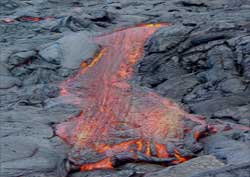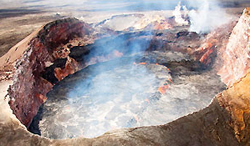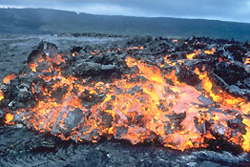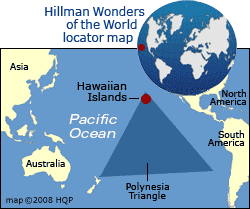Hawaii Volcanoes National Park
 Why the
Hawaii Volcanoes
National Park
is special
Why the
Hawaii Volcanoes
National Park
is specialThis vast and popular attraction on the island of Hawaii is home to Mauna Loa and Kilauea, two of the most active and exciting volcanoes in the world.
Most popular excursion routes
Caldera Drive
The 11-mile Caldera Drive is the most popular excursion route, with the Halema'uma'u Crater Overlook its highlight. From that observation spot, your camera can simultaneously capture the crater's interior and, in the distance, mighty Mauna Loa.
Other interesting Caldera Drive stops include Thurston Lava Tube, Jagger Museum, Steaming Bluff and the viewpoint behind the Volcano House.
Chain of Craters Road
This is the second most popular excursion route. It descends from Kilauea to the coast until it dead ends at a hardened street-crossing lava flow. The round trip is approximately 75 kilometers (45 miles).
When to sightsee
To avoid tour-bus crush, sightsee before mid-morning or after mid-afternoon.
 The two
major volcanoes
of the national park
The two
major volcanoes
of the national parkMauna Loa
It last major eruption occurred in 1984.One is expected again, likely within the next several decades.
Mauna Loa rises 4160 meters (13,677 feet) above sea level, but if you measure it from its base on the ocean floor, it's 9,400 meters (31,000 feet) tall, which is higher than Mount Everest.
Kilauea
Though considerably shorter than its sibling Mauna Loa, Kilauea attracts more tourists because it is the most active sizeable volcano on the planet.
And, Kilauea is relatively safer in the minds of visitors because it's less likely to cataclysmically blow its top.
Kilauea means "spreading, much spewing" in Hawaiian, which accurately describes what it usually does.
Geology
Mauna Loa and the neighboring Mauna Kea are gently, not sharply sloped as are most of the world's famous volcanoes. This is a geological characteristic of Hawaiian volcanoes.
 More
Hawaii Volcanoes
National Park
tips & insights
More
Hawaii Volcanoes
National Park
tips & insightsLava Flow
One of the leading sightseeing appeals is seeing live, scorching lava flows and, if you're lucky, gushing lava fountains.
Rather than wasting time driving around trying to find active lava flow, drop by the Visitor Center. The staff will tell you where the action is currently taking place.
Lava flows and fountains are visually more exciting after dusk. The molten lava intensely glows against the dark background.
Hiking trails
They are many and come in different persuasions, including those suited for simple-footers and backpackers.
Clothing
Wear layers of clothing because Hawaii Volcanoes National Park is a destination of extremes. On the same day, it's possible to walk on sandy tropical beaches and snow-covered terrain.
Polynesian Triangle
The Hawaiian Islands are the northern tip of a Pacific Ocean cultural zone known as the Polynesian Triangle (shown on map below). Easter Island and New Zealand define the other two tips.



